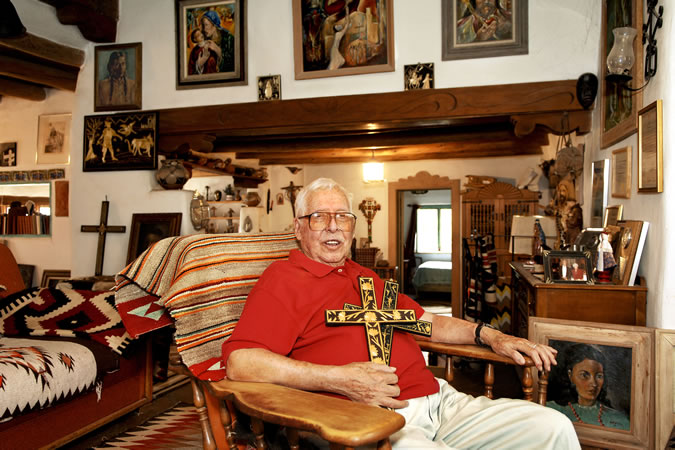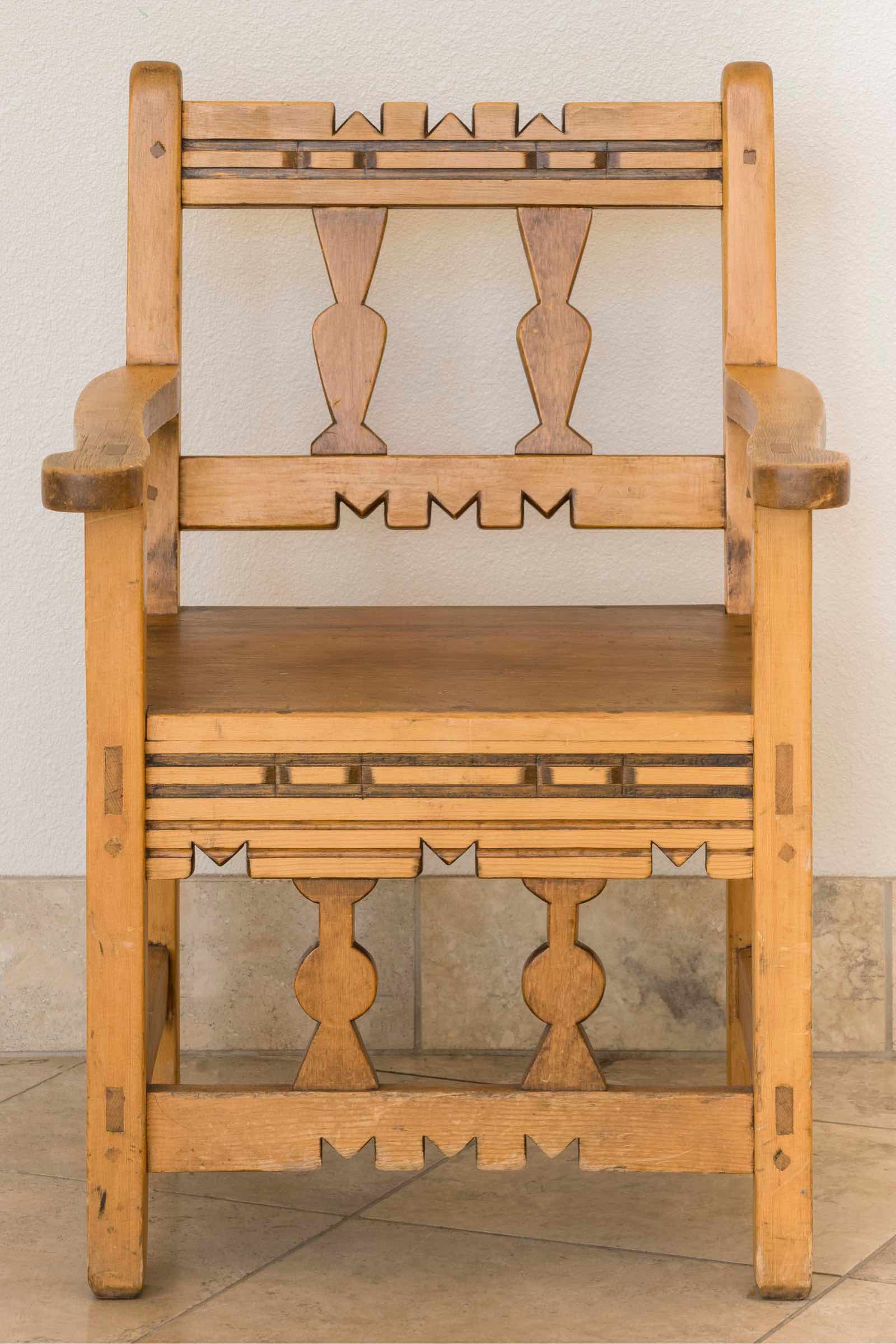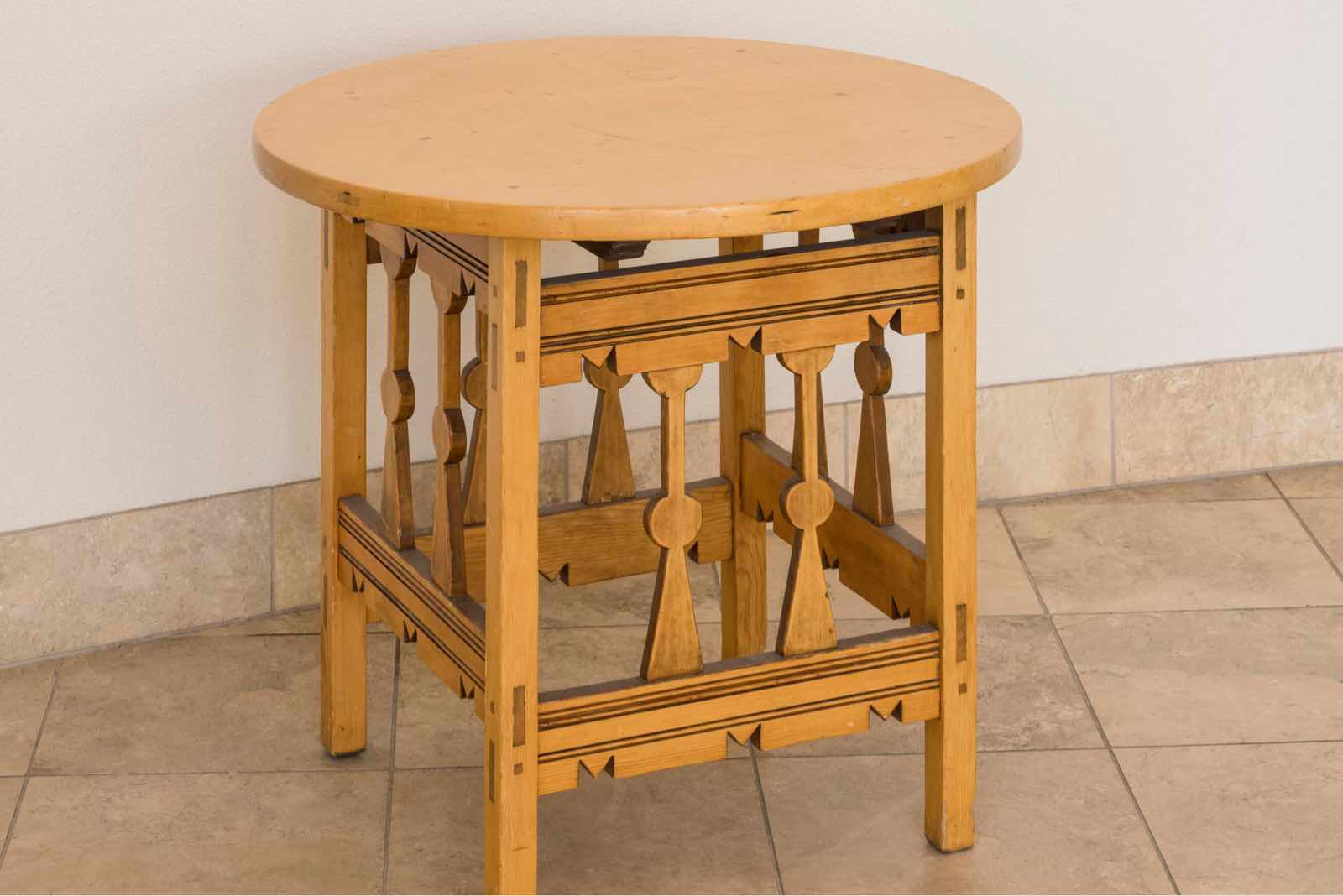Home » Special Exhibits » New Deal Nuevomexicano & Decorative Arts » Reviving Traditions
New Deal Nuevomexicano and Decorative Arts
Reviving Traditions
Mexican independence from Spain in 1821 led to the opening of borders and trade with the United States, mainly through the Santa Fe Trail. In turn, mechanized equipment supplanted handmade tools for farming and ranching and manufactured objects replaced hand-crafted arts, including furniture and decorative arts. The process of industrialization was further accelerated in New Mexico when it became part of the territorial United States in 1850. After the arrival of the transcontinental railroad in 1879 and the increase in tourism at the turn of the twentieth century, a group of Anglo elites and intellectuals in Santa Fe grew concerned that Nuevomexicanos were losing their “traditional” artistic practices.
In 1925, with the aim of cultural preservation, the group formed the Spanish Colonial Arts Society and began collecting historic arts and crafts. In 1926, the Society launched an annual Spanish Market (still in operation today) as a means of creating an economic outlet for hand-crafted Spanish Colonial arts and incentivizing their continued production. In the 1930s, the New Deal, interested in establishing a lineage and legacy of American art apart from and rival to that of western Europe (which was then the center of the Western art world), picked up the Society’s mantle. In a 1936 address, Federal Art Project (FAP) regional director Donald Baer declared the ability of Spanish Colonial art to “prove that we [the United States] have an indigenous art which is comparable to that of any past civilization.”4 Toward that end, the New Mexico FAP encouraged a revival of craftsmanship in earlier styles and techniques.
Look Closely
Look for the Artist’s Hand
Hover the magnifying glass over these objects and study their details.
What signs do you see that these objects were made by hand?
Dig Deeper
While the workshop model adopted by 1930s state vocational schools and New Deal programs may have resonated with historic means of production in New Mexico, it was markedly different in that it was implemented by Anglo administrators. The bulletins that molded school curricula and more broadly guided the production of furniture and decorative arts by Hispano artists were, with only one exception, compiled and edited by Anglo researchers and thus largely reflected Anglo interpretations of Spanish Colonial traditions. In fact, the majority of the bench, chair, and cabinet models heralded as exemplars of tradition by the “Spanish Colonial Furniture” bulletin (first published by the New Mexico Department of Vocational Education in 1933, and revised three times over the next six years) derive from the personal collection of Frank E. Applegate, co-founder of the Spanish Colonial Arts Society, and from other private collections. Thus, in determining standards of “authenticity,” state and federal arts administrations and the bulletins they produced were highly swayed by market forces—there was a large amount of crossover between what scholarship deemed traditional and what the art market valued (i.e., what would be appealing and convincing to outside consumers).
It follows that what the state vocational schools and New Deal programs codified through the bulletins were aspects of hand-craftsmanship that distinguished Nuevomexicano furniture within the broader Spanish Colonial tradition. The New Deal specifically sought to restore and maintain the particular practices of a distinct place and time: the northernmost province of New Spain prior to 1821. The focus was on the area that would ultimately become New Mexico and how it existed during the Spanish Empire, prior to Mexican Independence and the opening of the Santa Fe Trail (which ushered in new technologies). The northern provinces of New Spain (the Provincias Internas) were peripheral outposts, remotely located and lacking in resources. With few exceptions, they did not have access to the variety of tools and hard woods that were accessible in central New Spain, so furniture was created with the use of native soft woods and basic hand tools.
Implied in the New Deal’s emphasis on pre-1821 Nuevomexicano furniture is a romanticized, primitivist ideology—a desire to return to the “original,” “untouched,” and “pure” ideal. Some New Deal and related publications overtly express the implied. For example, the 1941 book Spanish Colonial Furniture by A. D. Williams states that, “to judge by the few original pieces available for study, the Spanish colonial furniture maker was not the best of craftsmen . . . The craftsman was too busy fighting for a bare living to take much time for doing fine cabinet-work.”5 Likewise, E. Boyd writes in the Portfolio of Spanish Colonial Design that “while the rest of the white race was advancing in the cycle of industrial development, the New Mexico craftsmen were building a school of art unlike any other, but which carried on the tradition of the pre-industrial period.”6
Look Again
Look for Principles of Design and Craftsmanship that Emphasize Pre-Industrial Handicraft
Uncredited Hispano Artist(s)
Chair
About 1930s
Pine
23” W x 35” H x 18¾” D
Soft Wood
In the urban centers of New Spain, access to hard woods made ornately and intricately carved furniture the fashion. In the northern Spanish provinces, however, the most readily available wood was (and still is) pine, a soft wood. The nature of the material meant decorative designs had to be adapted—elaborate motifs were simplified, hard lines were softened, and furniture took on an overall “rounder” look. This especially applied to corners and edges. As the “Spanish Colonial Furniture” bulletin explains: “we find round edges in place of sharp edges in most of the old pine furniture, for if the edge were left sharp, as is commonly done in hard wood, there was a danger of splintering.” Notice the rounded corners of this chair’s “ears,” the circular shape of the ends of its arms, and the curvature of its splats.
Uncredited Hispano Artist(s), likely Elidio Gonzales
Table
About 1930s
Pine
22” W x 29¼” H x 22” D with 34” diameter top
Mortise and Tenon Joinery
While concealed joints were standard for furniture-making in the central areas of New Spain, the softness of pine wood, with its tendency to warp and shrink, necessitated a different type of joinery in the colony’s northern provinces. Mortise and tenon joints are a hallmark of Nuevomexicano furniture. Square pegs are used as tenons, which are left exposed, “cut off flush with the surface and well-smoothed” (as described in the “Spanish Colonial Furniture” bulletin).
Trastero
About 1930s
Pine
48 1/4” W x 51” H x 18 1/4” D
Mudéjar (Islamic-Christian) Motifs
As the “Spanish Colonial Furniture” bulletin describes, craftsmen in New Spain’s northern provinces carried forward designs from the medieval period in Spain (711–1492). (It patronizingly credits this continuation to the northern provinces’ geographical distance from port cities and trade routes and subsequent ignorance of European cultural and artistic developments.) During this period, the blending of Islamic and Christian visual vocabularies led to the emergence of a style known as Mudéjar. The hewn spindles, relief-carved rosettes, and scallop shells seen on the doors of this trastero (cabinet) are classic Mudéjar design elements.
Trastero
About 1930s
Pine
47¾” W x 72” H x 17¾” D
Use of Hand Tools
This trastero epitomizes pre-1821 Nuevomexicano craftsmanship, as the artist has made ample use of hand tools, adding a “bullet” chip-carved border between the doors and along the edges, and a chiseled background to the relief carvings.
Eliseo Rodriguez
Eliseo Rodriguez was a key player in the New Deal’s plan to revive Spanish Colonial artistic traditions. Through his work on the Portfolio of Spanish Colonial Design, Rodriguez became acquainted with project supervisor E. Boyd (who would later be a curator of Spanish Colonial art at the Museum of New Mexico Art Gallery and then the Santa Fe Museum of International Folk Art). Boyd introduced Rodriguez to straw appliqué, a lost art she is credited with “rediscovering” through research. As Rodriguez tells it, “She [Boyd] said that this form of straw art originated in Africa, was picked up by the Moors in Spain and brought by the Spanish to New Mexico. It was tacky, messy, and tedious work . . . I was willing to try anything so I tried doing the straw inlay appliqué work and enjoyed doing it and wanted to keep it going as a form of art that was dying out.” 7
Eventually, Rodriguez became a maestro, or master, of the craft, incorporating designs and motifs from historical records and improvising his own technique and style. In 2004, he and his wife, Paula, also a maestra of straw appliqué, were named National Heritage Fellows by the National Endowment for the Arts for their work regenerating the art form.

The artist pictured in 2004, after receiving the National Endowment for the Arts National Heritage Fellowship. Photograph by Tom Pich.




